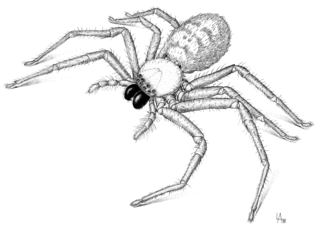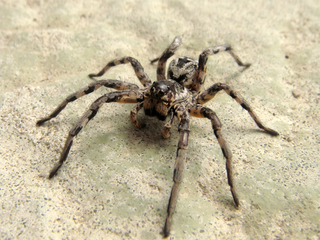
Huntsman spiders, members of the family Sparassidae, are known by this name because of their speed and mode of hunting. They are also called giant crab spiders because of their size and appearance. Larger species sometimes are referred to as wood spiders, because of their preference for woody places. In southern Africa the genus Palystes are known as rain spiders or lizard-eating spiders. Commonly, they are confused with baboon spiders from the Mygalomorphae infraorder, which are not closely related.

Parasteatoda tepidariorum, the common house spider or American house spider, is a spider species of the genus Parasteatoda with a cosmopolitan distribution. Common house spiders are synanthropic and live in and near human dwellings. Their prey mechanism is similar to that of the other cobweb spiders: the spider follows disturbances transmitted along the web to entangle and then paralyze its prey, which usually consists of household insects and other invertebrates.

A tarantula hawk is a spider wasp (Pompilidae) that preys on tarantulas. Tarantula hawks belong to any of the many species in the genera Pepsis and Hemipepsis. They are one of the largest parasitoid wasps, using their sting to paralyze their prey before dragging it to a brood nest as living food; a single egg is laid on the prey, hatching to a larva which eats the still-living prey.

Wasps in the family Pompilidae are commonly called spider wasps, spider-hunting wasps, or pompilid wasps. The family is cosmopolitan, with some 5,000 species in six subfamilies. Nearly all species are solitary, and most capture and paralyze prey, though members of the subfamily Ceropalinae are kleptoparasites of other pompilids, or ectoparasitoids of living spiders.

Delena cancerides, the flat huntsman or social huntsman, is a large, brown huntsman spider native to Australia. It has been introduced to New Zealand, where it is sometimes known as the Avondale spider as they are commonly found in the suburb of Avondale, Auckland. This was the species used in the Australian movie Napoleon and widely in Arachnophobia, and all films depict them as having a deadly venomous bite, but they are generally considered harmless to humans in real-life. It was first described by Charles Athanase Walckenaer in 1837.

The Goliath birdeater belongs to the tarantula family Theraphosidae. Found in northern South America, it is the largest spider in the world by mass – 175 g (6.2 oz) – and body length – up to 13 cm (5.1 in) – but it is second to the giant huntsman spider by leg span. It is also called the Goliath bird-eating spider; the practice of calling theraphosids "bird-eating" derives from an early 18th-century copper engraving by Maria Sibylla Merian that shows one eating a hummingbird. Despite the spider's name, it rarely preys on birds.

Lycosa tarantula is the species originally known as the tarantula, a name that nowadays in English commonly refers to spiders in another family entirely, the Theraphosidae. It now may be better called the tarantula wolf spider, being in the wolf spider family, the Lycosidae. L. tarantula is a large species found in southern Europe, especially in the Apulia region of Italy and near the city of Taranto, from which it gets its name.

The emerald cockroach wasp or jewel wasp is a solitary wasp of the family Ampulicidae. It is known for its unusual reproductive behavior, which involves stinging a cockroach and using it as a host for its larvae. It thus belongs to the entomophagous parasites.
Spider behavior refers to the range of behaviors and activities performed by spiders. Spiders are air-breathing arthropods that have eight legs and chelicerae with fangs that inject venom. They are the largest order of arachnids and rank seventh in total species diversity among all other groups of organisms which is reflected in their large diversity of behavior.

Porrhothele antipodiana, the black tunnelweb spider, is a spider found throughout much of New Zealand and the Chatham Islands in bush and gardens and is one of New Zealand's most researched spiders. It is related to tarantulas, and is a harmless relative of the venomous Australian funnel-web spider.

Tarantulas comprise a group of large and often hairy spiders of the family Theraphosidae. Currently, 1,010 species have been identified. The term "tarantula" is usually used to describe members of the family Theraphosidae, although many other members of the same infraorder (Mygalomorphae) are commonly referred to as "tarantulas" or "false tarantulas". Some of the more common species have become popular in the exotic pet trade. Many New World species kept as pets have setae known as urticating hairs that can cause irritation to the skin, and in extreme cases, cause damage to the eyes.
Hysterocrates gigas is a member of the tarantula family, Theraphosidae found in Cameroon. It is known as the giant baboon spider, Cameroon red baboon spider, or red baboon tarantula.

A wasp is any insect of the narrow-waisted suborder Apocrita of the order Hymenoptera which is neither a bee nor an ant; this excludes the broad-waisted sawflies (Symphyta), which look somewhat like wasps, but are in a separate suborder. The wasps do not constitute a clade, a complete natural group with a single ancestor, as bees and ants are deeply nested within the wasps, having evolved from wasp ancestors. Wasps that are members of the clade Aculeata can sting their prey.

The wheel spider or golden wheel spider, is a huntsman spider native to the Namib Desert of Southern Africa. This spider should not be confused with Leucorchestris arenicola, a spider sharing the same common name as well as the same locale. The spider escapes parasitic pompilid wasps by flipping onto its side and cartwheeling down sand dunes at speeds of up to 44 turns per second.

The Texas brown tarantula, also known as Oklahoma brown tarantula or Missouri tarantula, is one of the most common species of tarantula living in the Southern United States today. Texas brown tarantulas can grow to leg spans in excess of 4 in (10 cm), and weigh more than 3 oz as adults. Their bodies are dark brown, though shades may vary between individual tarantulas. The colors are more distinct after a molt, as with many arthropods.

Spiders are air-breathing arthropods that have eight legs, chelicerae with fangs generally able to inject venom, and spinnerets that extrude silk. They are the largest order of arachnids and rank seventh in total species diversity among all orders of organisms. Spiders are found worldwide on every continent except for Antarctica, and have become established in nearly every land habitat. As of August 2021, 49,623 spider species in 129 families have been recorded by taxonomists. However, there has been dissension within the scientific community as to how all these families should be classified, as evidenced by the over 20 different classifications that have been proposed since 1900.

Hemipepsis ustulata is a species of tarantula hawk wasp native to the Southwestern United States. Tarantula hawks are a large, conspicuous family of long-legged wasps which prey on tarantulas. They use their long legs to grapple with their prey before paralyzing them with a powerful sting. Their stings are ranked second-most painful in the insect world. They are solitary, displaying lekking territorial behavior in their mating rituals.

Eucteniza is a genus of trapdoor spiders in the family Euctenizidae containing at least 14 species occurring in Mexico and the southern United States. Species are distinguished by a softened rear portion of the carapace, and males possess large spines on the first two pairs of walking legs that are used to hold females during mating. Like other trapdoor spiders they create burrows with a hinged lid, from which they await passing insects and other arthropods to prey upon. Many species are known from only one or two localities, or from only male specimens. More species are expected to be discovered. Eucteniza is closely related to spiders of the genera Entychides and Neoapachella.

Pepsis grossa is a very large species of pepsine spider wasp from the southern part of North America, south to northern South America. It preys on tarantula spiders, giving rise to the name tarantula hawk for the wasps in the genus Pepsis and the related Hemipepsis. Only the females hunt, so only they are capable of delivering a sting, which is considered the second most painful of any insect sting; scoring 4.0 on the Schmidt sting pain index compared to the bullet ant's 4.0+. It is the state insect of New Mexico. The colour morphs are the xanthic orange-winged form and the melanic black winged form. In northern South America, a third form, known as "lygamorphic", has a dark base to the wings which have dark amber median patches and a pale tip.

















